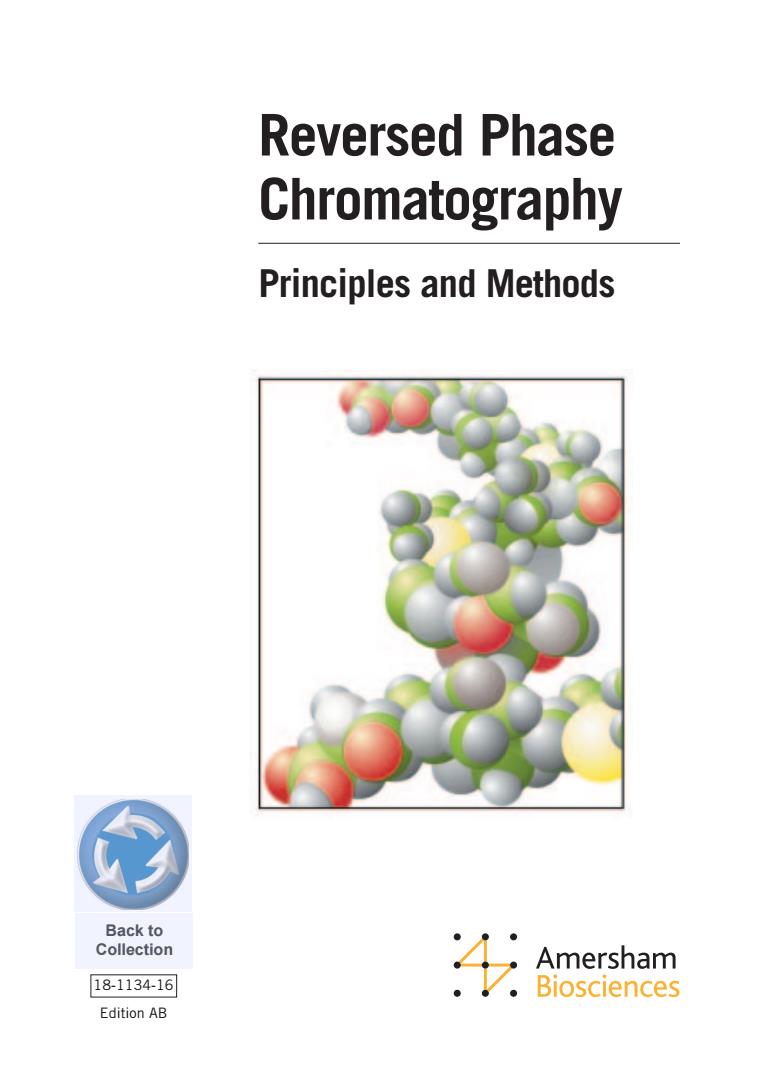
Reversed Phase Chromatography Principles and Methods Back to Collection Amersham 18-1134-16 Biosciences Edition AB
18-1134-16 Reversed Phase Chromatography Principles and Methods Edition AB
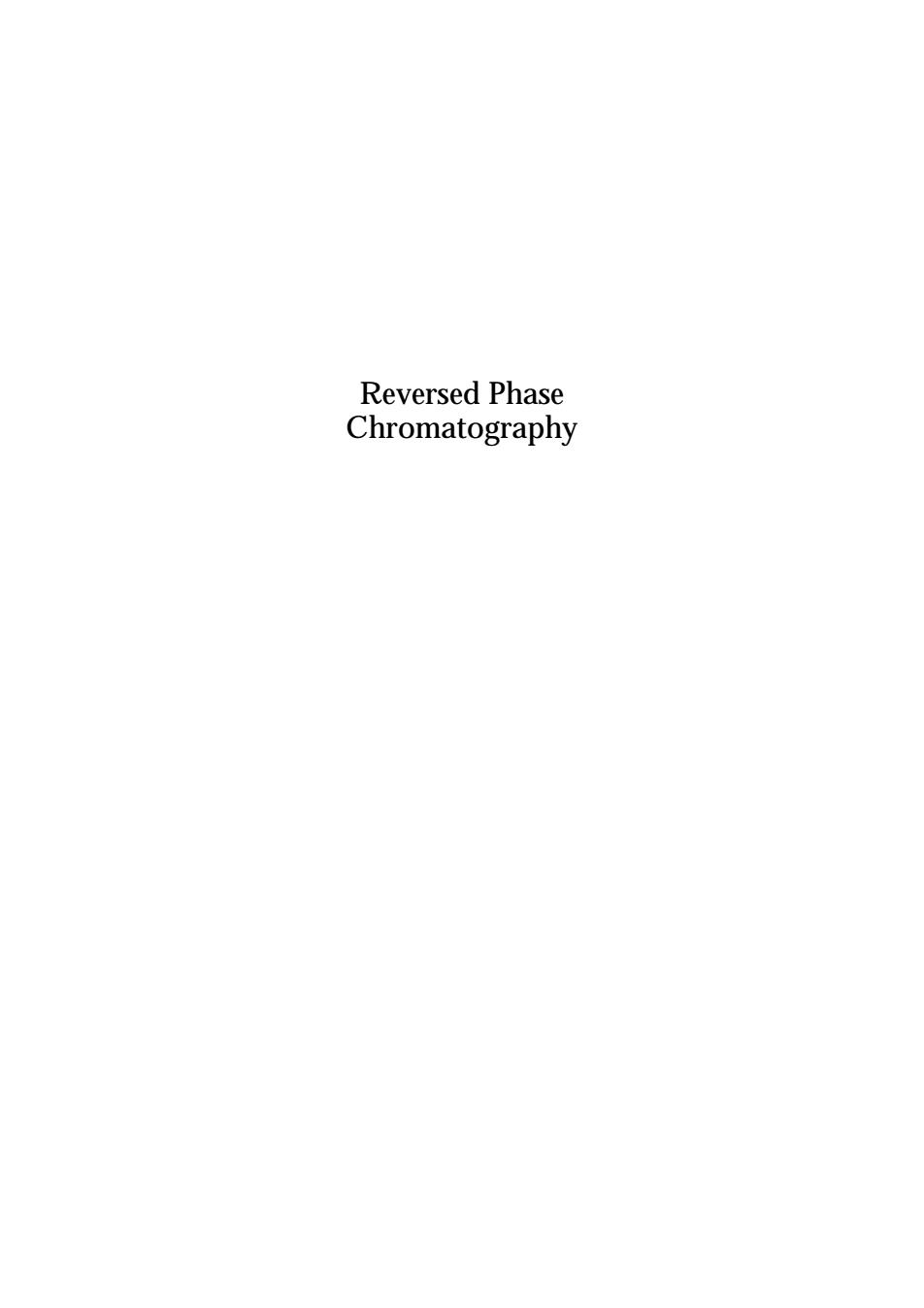
Reversed Phase Chromatography
Reversed Phase Chromatography
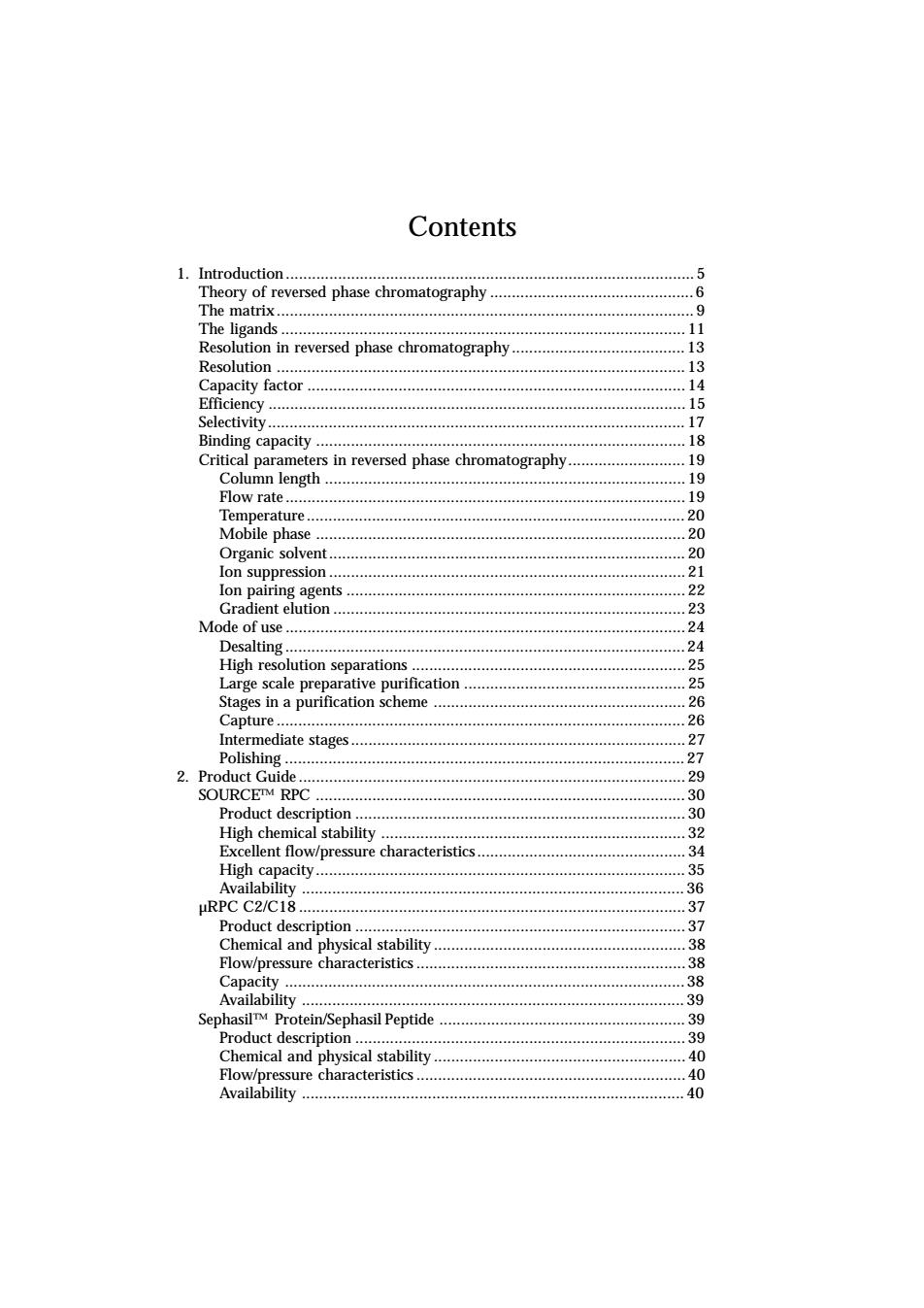
Contents 1.Introduction. 5 Theory of reversed phase chromatography .6 The matrix chromatography 1 1 Capacity factor 14 Efficiency 15 Selectivity. 17 Binding capacity Critical para rs in reversed phase chromatography. 10 erature 20 Mobile phase 20 Organic solvent Ion suppression 22 Mode of use Desalting 24 High resolution separations 25 Large scale preparative purification. 25 Stages in a purification scheme Captur 2.Product Guide SOURCETM RPC 30 Product description 30 μRPCC2/C18 Product description. 37 Chemical and physical stability 38 Flow/pressure characteristics. Sephasil Peptide 30 Product description. 39 Chemical and physical stability 40 Flow/pressure characteristics. Availability
Contents 1. Introduction .5 Theory of reversed phase chromatography .6 The matrix .9 The ligands . 11 Resolution in reversed phase chromatography . 13 Resolution . 13 Capacity factor . 14 Efficiency . 15 Selectivity. 17 Binding capacity . 18 Critical parameters in reversed phase chromatography. 19 Column length .19 Flow rate .19 Temperature. 20 Mobile phase . 20 Organic solvent. 20 Ion suppression . 21 Ion pairing agents . 22 Gradient elution . 23 Mode of use .24 Desalting .24 High resolution separations . 25 Large scale preparative purification . 25 Stages in a purification scheme . 26 Capture . 26 Intermediate stages .27 Polishing .27 2. Product Guide .29 SOURCE™ RPC . 30 Product description . 30 High chemical stability . 32 Excellent flow/pressure characteristics. 34 High capacity. 35 Availability . 36 µRPC C2/C18 .37 Product description . 37 Chemical and physical stability . 38 Flow/pressure characteristics .38 Capacity .38 Availability . 39 Sephasil™ Protein/Sephasil Peptide . 39 Product description . 39 Chemical and physical stability . 40 Flow/pressure characteristics .40 Availability . 40
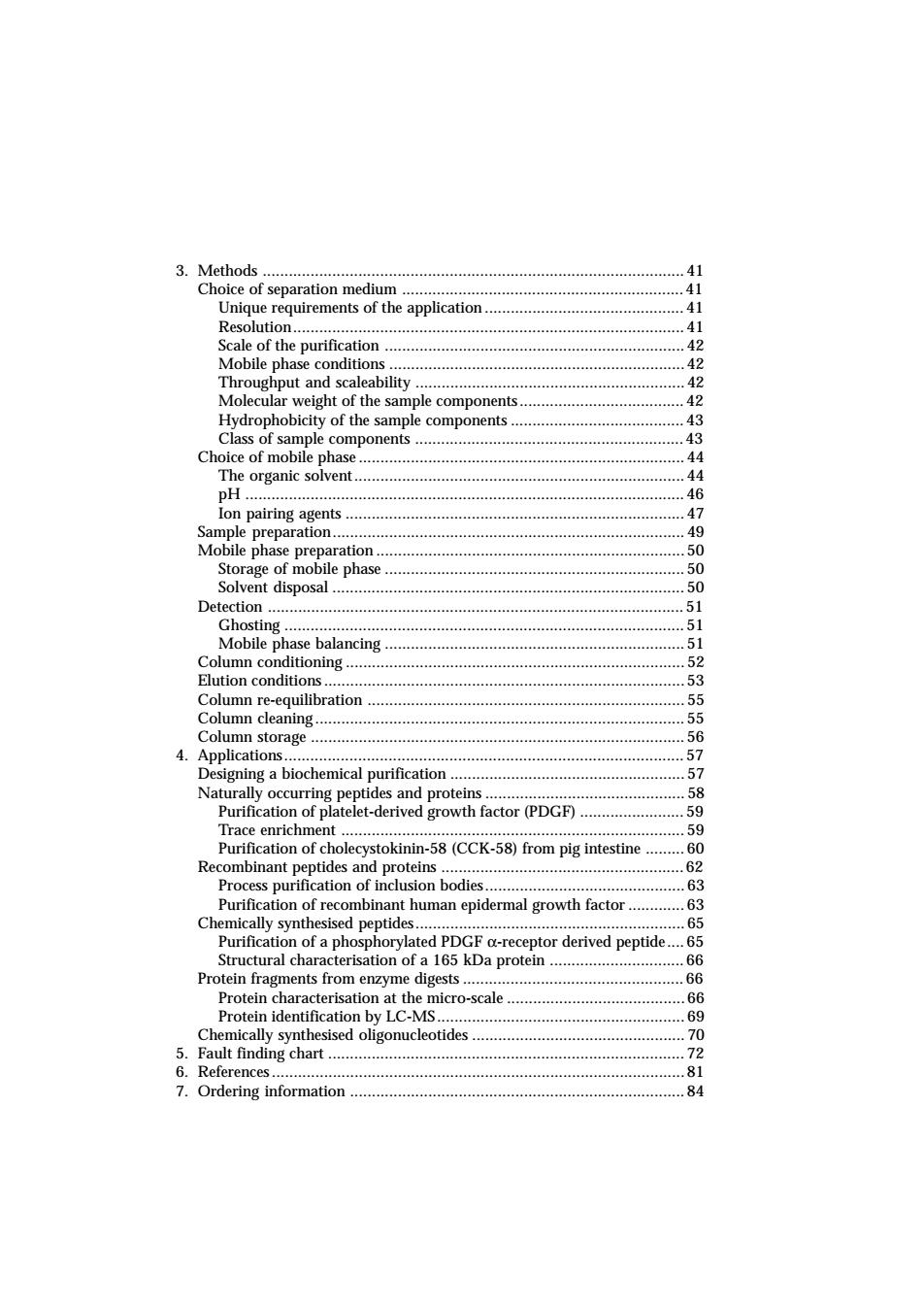
3.Methods Ch Scale of the purification Mobile phase conditions Throughput and scaleability Molecu lar weight of the sample components. ydrophobic ity of the sample components Ch. components The organic solvent. DH 46 lon pairing agents .47 ile phase prepara 445050 Detection 51 Ghosting. 51 Mobile phase balancing. mn re ration Column storage 4.Applications .57 Designing a biochemical purification. .5 stokinin-58(CCK-8)from pig intestine ptides and proteins 6 Process purification of inclusion bodies. 63 Purification of recombinant human epidermal growth factor. .63 Chemically synthesised peptides a-rec Protein fragn ts fron Protein characterisation at the micro-scale 66 Protein identification by LC-MS. 69 Chemically synthesised oligonucleotides. 56. Fault finding chart
3. Methods . 41 Choice of separation medium .41 Unique requirements of the application . 41 Resolution. 41 Scale of the purification . 42 Mobile phase conditions .42 Throughput and scaleability .42 Molecular weight of the sample components.42 Hydrophobicity of the sample components . 43 Class of sample components .43 Choice of mobile phase . 44 The organic solvent. 44 pH .46 Ion pairing agents . 47 Sample preparation. 49 Mobile phase preparation .50 Storage of mobile phase . 50 Solvent disposal . 50 Detection . 51 Ghosting .51 Mobile phase balancing . 51 Column conditioning . 52 Elution conditions .53 Column re-equilibration . 55 Column cleaning . 55 Column storage .56 4. Applications.57 Designing a biochemical purification . 57 Naturally occurring peptides and proteins . 58 Purification of platelet-derived growth factor (PDGF) . 59 Trace enrichment . 59 Purification of cholecystokinin-58 (CCK-58) from pig intestine . 60 Recombinant peptides and proteins .62 Process purification of inclusion bodies. 63 Purification of recombinant human epidermal growth factor . 63 Chemically synthesised peptides.65 Purification of a phosphorylated PDGF α-receptor derived peptide. 65 Structural characterisation of a 165 kDa protein . 66 Protein fragments from enzyme digests . 66 Protein characterisation at the micro-scale .66 Protein identification by LC-MS. 69 Chemically synthesised oligonucleotides . 70 5. Fault finding chart . 72 6. References .81 7. Ordering information .84
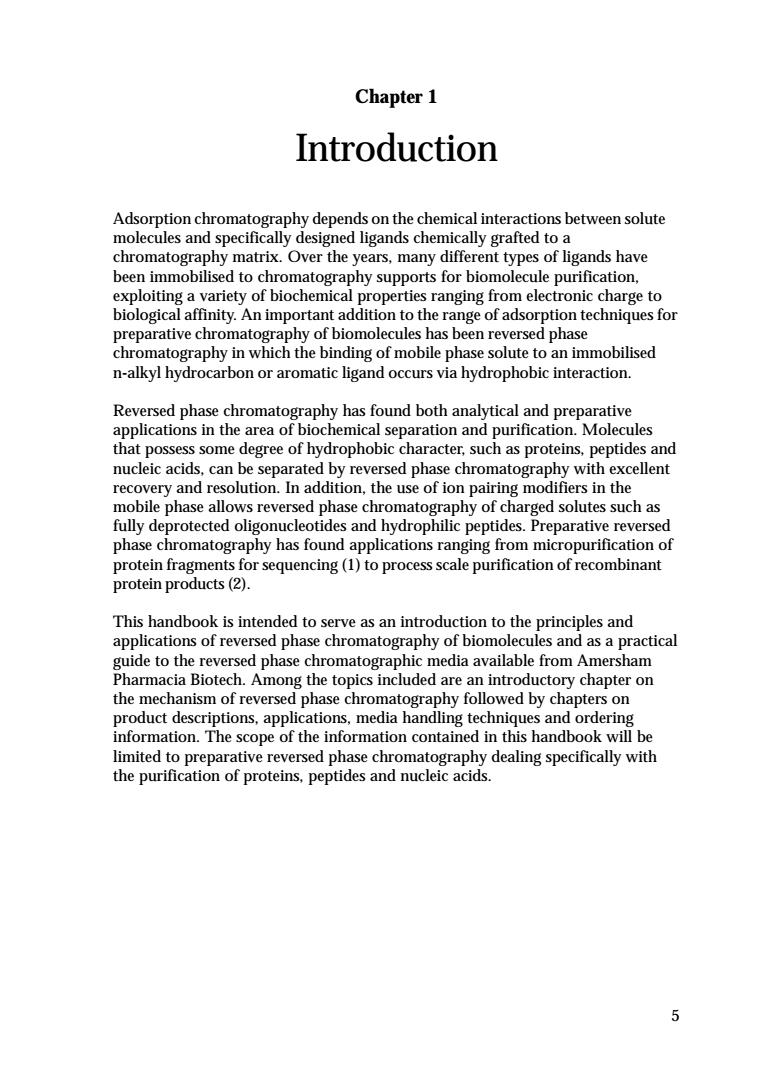
Chapter 1 Introduction tography depedon the chemical interactions between solte ned ligands che nically grafted t rent types of ligands have been immobilised to chromatography supports for biomolecule purification, exploiting a variety of biochemical properties ranging from electronic charge to biological affinity.An important addition to the range of adsorption techniques for preparative chromatography of biomolecules has been reversed phase chromatography in which the binding of mobile phase solute to an immobilised n-alkyl hydrocarbon or aromatic ligand occurs via hydrophobic interaction. Reversed phase chromatography has found both analytical and preparative applications in the area of biochemical separation and purification.Molecules that possess so nucleic acids e of hdrophobterproidd can be sep ate ersed ph e use of io atograp llent n pa ng mo pha ged sol ithe tes such as reverse phase chromatography has found applications ranging from micropurification of protein fragments for sequencing(1)to process scale purification of recombinant protein products(2). This handbook is intended to serve as an introduction to the principles and applications of reversed phase chromatography of biomolecules and as a practical guide to the reversed phase chromatographic media available from Amersham Pharmacia Biotech.Amc ng the topics included are an introductory chapter on the mechanism of reversed phase chron IS. applicat s,media h dli techniques and orderin nation.The co f the info rma ed in is handbook will be imited prepara ve reversed pha se ch oma graph dealing specifically with the of proteins.peptidesand 5
5 Chapter 1 Introduction Adsorption chromatography depends on the chemical interactions between solute molecules and specifically designed ligands chemically grafted to a chromatography matrix. Over the years, many different types of ligands have been immobilised to chromatography supports for biomolecule purification, exploiting a variety of biochemical properties ranging from electronic charge to biological affinity. An important addition to the range of adsorption techniques for preparative chromatography of biomolecules has been reversed phase chromatography in which the binding of mobile phase solute to an immobilised n-alkyl hydrocarbon or aromatic ligand occurs via hydrophobic interaction. Reversed phase chromatography has found both analytical and preparative applications in the area of biochemical separation and purification. Molecules that possess some degree of hydrophobic character, such as proteins, peptides and nucleic acids, can be separated by reversed phase chromatography with excellent recovery and resolution. In addition, the use of ion pairing modifiers in the mobile phase allows reversed phase chromatography of charged solutes such as fully deprotected oligonucleotides and hydrophilic peptides. Preparative reversed phase chromatography has found applications ranging from micropurification of protein fragments for sequencing (1) to process scale purification of recombinant protein products (2). This handbook is intended to serve as an introduction to the principles and applications of reversed phase chromatography of biomolecules and as a practical guide to the reversed phase chromatographic media available from Amersham Pharmacia Biotech. Among the topics included are an introductory chapter on the mechanism of reversed phase chromatography followed by chapters on product descriptions, applications, media handling techniques and ordering information. The scope of the information contained in this handbook will be limited to preparative reversed phase chromatography dealing specifically with the purification of proteins, peptides and nucleic acids